Table of Contents
Flowers are a universal symbol of beauty, emotions, and nature. Learning flowers vocabulary is essential for beginners who want to improve their English skills. This guide introduces common flower names, their meanings, and how to use them in sentences.
Whether you are describing a garden, giving a gift, or learning for fun, mastering flower vocabulary will make your English more expressive and confident.
Common Flower Names
- Rose
- Tulip
- Lily
- Daisy
- Sunflower
- Orchid
- Jasmine
- Lavender
- Marigold
- Poppy
- Carnation
- Chrysanthemum
- Daffodil
- Peony
- Hibiscus
- Iris
- Geranium
- Begonia
- Violet
- Hydrangea
- Camellia
- Azalea
- Petunia
- Zinnia
- Dahlia
- Gladiolus
- Aster
- Anemone
- Freesia
- Amaryllis
- Snapdragon
- Cosmos
- Calla Lily
- Morning Glory
- Bluebell
- Buttercup
- Foxglove
- Magnolia
- Gardenia
- Nasturtium
- Sweet Pea
- Phlox
- Verbena
- Canna Lily
- Crocus
- Snowdrop
- Primrose
- Lantana
- Delphinium
- Lupine
- Alyssum
- Scabiosa
- Bellflower
- Coreopsis
- Yarrow
- Tithonia
- Lobelia
- Nemesia
- Heliotrope
- Gaillardia
- Lisianthus
- Stock
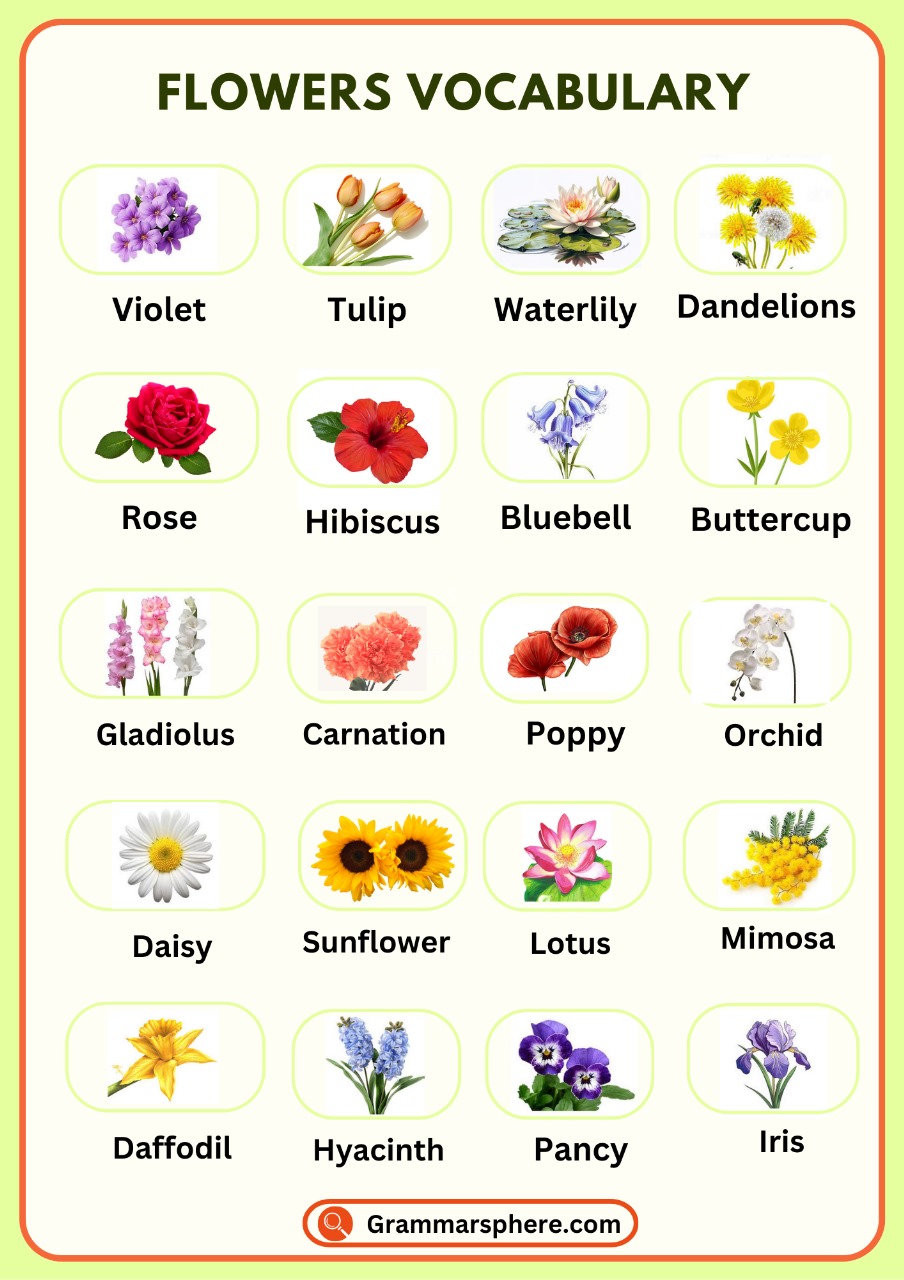
Types of Flowers and Examples
1. Annual Flowers
These flowers complete their life cycle in one growing season.
- Marigold
- Petunia
- Zinnia
- Cosmos
- Pansy
- Impatiens
- Sunflower
2. Perennial Flowers
These flowers bloom year after year without needing to be replanted.
- Rose
- Lavender
- Peony
- Daisy
- Chrysanthemum
- Iris
- Daylily
3. Biennial Flowers
These flowers take two years to complete their life cycle.
- Foxglove
- Sweet William
- Hollyhock
- Canterbury Bells
4. Bulb Flowers
These flowers grow from bulbs, corms, or tubers.
- Tulip
- Daffodil
- Hyacinth
- Crocus
- Amaryllis
- Lily
- Calla Lily
5. Wildflowers
Flowers that grow naturally in the wild without cultivation.
- Poppy
- Bluebell
- Buttercup
- Black-eyed Susan
- Indian Paintbrush
- Cornflower
6. Tropical Flowers
These flowers thrive in warm and humid climates.
- Orchid
- Hibiscus
- Bird of Paradise
- Plumeria
- Bougainvillea
- Anthurium
- Heliconia
7. Water Flowers
Flowers that grow in or near water bodies.
- Lotus
- Water Lily
- Canna
- Pickerelweed
8. Climbing and Vine Flowers
These flowers grow on vines or climb using support.
- Morning Glory
- Clematis
- Wisteria
- Passionflower
- Honeysuckle
- Jasmine
9. Fragrant Flowers
These flowers are known for their pleasant scent.
- Jasmine
- Gardenia
- Rose
- Lavender
- Freesia
- Lilac
- Tuberose
10. Exotic Flowers
Rare or unique flowers found in specific regions.
- Protea
- Rafflesia
- Titan Arum (Corpse Flower)
- Chocolate Cosmos
- Bat Flower
- Flame Lily
Common Flower Names with Descriptions
1. Rose
Roses are one of the most loved flowers, known for their soft, fragrant petals and beautiful colors like red, pink, yellow, and white. They are often seen as a symbol of love and romance.
2. Tulip
Tulips are bright, cup-shaped flowers that bloom in the spring. They come in various colors, including red, yellow, and purple, and are admired for their simple yet elegant look.
3. Lily
Lilies are large, trumpet-shaped flowers with a sweet fragrance. They come in colors like white, orange, and pink and are often used in weddings and special occasions.
4. Daisy
Daisies are cheerful flowers with white petals and a yellow center. They symbolize purity and simplicity and often grow in fields and gardens.
5. Sunflower
Sunflowers are tall flowers with large yellow petals and dark centers. They are known for following the sun and are a symbol of happiness and energy.
6. Orchid
Orchids are exotic flowers with unique, delicate shapes. They come in many colors and are often grown indoors as houseplants.
7. Jasmine
Jasmine is a small, white, star-shaped flower with a strong, sweet fragrance. It is often used in perfumes and teas.
8. Lavender
Lavender is a purple flower known for its calming scent. It is used in oils, soaps, and sachets to promote relaxation.
9. Marigold
Marigolds are bright orange or yellow flowers with layered petals. They are often used in festivals and ceremonies and are easy to grow.
10. Poppy
Poppies are delicate flowers with thin, silky petals in colors like red, orange, and pink. They are often associated with remembrance and peace.
11. Carnation
Carnations are ruffled flowers that come in many colors, such as red, pink, and white. They are often used in bouquets and symbolize love and admiration.
12. Chrysanthemum
Chrysanthemums, or “mums,” are round, layered flowers that bloom in the fall. They come in various colors and are a symbol of friendship and happiness.
13. Daffodil
Daffodils are bright yellow, trumpet-shaped flowers that bloom in early spring. They are a symbol of new beginnings and cheerfulness.
14. Peony
Peonies are large, fluffy flowers with soft petals. They bloom in shades of pink, white, and red and are often used in weddings as a symbol of romance.
15. Hibiscus
Hibiscus flowers are large and colorful with five petals. They are often found in tropical areas and are a symbol of beauty and relaxation.
16. Iris
Irises are elegant flowers with petals that look like they are folded. They come in purple, blue, and yellow and symbolize hope and wisdom.
17. Gardenia
Gardenias are creamy white flowers with glossy leaves and a strong, sweet fragrance. They are often used in perfumes and symbolize purity.
18. Magnolia
Magnolias are large, fragrant flowers that bloom on trees. They are usually white or pink and are admired for their beauty and elegance.
19. Bluebell
Bluebells are tiny, bell-shaped flowers that grow in clusters. They are usually blue or purple and are a symbol of humility and gratitude.
20. Hydrangea
Hydrangeas are round clusters of small flowers that bloom in colors like blue, pink, and white. They are a symbol of gratitude and abundance.
no need to provide description… just make four rows and mention all popular flowers in table
Popular Flower Names
| Rose | Tulip | Lily | Daisy |
| Sunflower | Orchid | Jasmine | Lavender |
| Marigold | Poppy | Carnation | Chrysanthemum |
| Daffodil | Peony | Hibiscus | Iris |
| Gardenia | Magnolia | Bluebell | Hydrangea |
| Camellia | Azalea | Petunia | Zinnia |
| Dahlia | Gladiolus | Morning Glory | Foxglove |
| Freesia | Calla Lily | Snapdragon | Cosmos |
Flowers for Events
Wedding Flowers
- Rose:
Symbolizes love and romance, making it a classic wedding flower.
- Orchid:
Elegant and exotic, often used in bouquets and centerpieces.
- Calla Lily:
Known for its sleek, modern appearance, perfect for sophisticated weddings.
- Jasmine:
Sweet-smelling flower often added to bouquets and floral arrangements.
Birthday Flowers
- Lily:
Bright, colorful, and joyful, ideal for birthday celebrations.
- Sunflower:
Represents happiness and warmth, making it a great choice for a birthday.
- Gerbera Daisy:
Cheerful and vibrant, perfect for birthday decorations.
- Poppy:
Known for its bold colors and lively appearance, often used for a fun birthday vibe.
Anniversary Flowers
- Tulip:
Symbolizes perfect love, making it ideal for anniversaries.
- Peony:
Represents a happy marriage, love, and good fortune.
- Daffodil:
Signifies renewal and new beginnings, great for a fresh start together.
- Violet:
Represents loyalty and faithfulness, perfect for celebrating lasting love.
Funeral Flowers
- Chrysanthemum:
A symbol of remembrance and grief, commonly used in funeral arrangements.
- Carnation:
Often used in funeral wreaths to express love and admiration.
- Rose:
White roses symbolize purity and innocence, making them a respectful choice for funerals.
- Lily:
A symbol of peace and the soul’s return to innocence, often seen in funeral bouquets.
Edible Flowers and Their Names
Edible flowers can be used in cooking, baking, and as garnishes. They are safe to eat and can add color, flavor, and texture to dishes. Here are some common edible flowers:
Rose
Rose petals can be used to make jams, syrups, or as a garnish. They have a sweet, fragrant flavor.
Lavender
Lavender is often used in desserts like cakes and cookies. It has a floral, slightly sweet taste.
Pansy
Pansies are colorful flowers that can be used in salads, desserts, and drinks. They have a mild, grassy flavor.
Violet
Violets are sweet and slightly floral, perfect for garnishing cakes, adding to salads, or making violet syrup.
Dandelion
Dandelions are often used in salads, teas, and even wine. The leaves are slightly bitter, while the flowers are sweet.
Chamomile
Chamomile flowers are often used in teas and have a mild, apple-like taste.
Marigold
Marigold petals are edible and have a citrus-like flavor. They can be added to salads or used as a garnish.
Borage
Borage flowers have a cucumber-like taste. They are often used in salads or cocktails.
Calendula
Calendula petals have a peppery flavor and are used in salads, soups, or as a garnish.
Nasturtium
Nasturtiums have a peppery, mustard-like flavor and can be added to salads or used as a garnish on dishes.
Scientific Flower Names and Descriptions
Rosa (Rose)
Roses are known for their beauty and fragrance. They come in many colors and are often symbols of love.
Tulipa (Tulip)
Tulips are spring-blooming flowers with bright, cup-shaped petals. They are popular in gardens and floral arrangements.
Lilium (Lily)
Lilies are large, trumpet-shaped flowers that are fragrant and come in various colors, often used in weddings.
Helianthus (Sunflower)
Sunflowers are tall plants with large, bright yellow petals and are known for following the sun’s movement.
Orchidaceae (Orchid)
Orchids are exotic flowers known for their delicate and unique shapes. They come in a wide range of colors.
Jasminum (Jasmine)
Jasmine flowers are small, white or yellow flowers known for their strong, sweet fragrance.
Lavandula (Lavender)
Lavender is a fragrant flower that produces purple blooms and is often used in oils and perfumes.
Chrysanthemum (Chrysanthemum)
Chrysanthemums are flowers that bloom in fall, with layered petals in colors like red, yellow, and white.
Crocus (Crocus)
Crocuses are small, early spring flowers that often bloom in shades of purple, yellow, and white.
Narcissus (Daffodil)
Daffodils are trumpet-shaped flowers that bloom in spring, usually yellow or white, symbolizing new beginnings.
Types of Flowers by Color
1. Red Flowers
- Rose
- Tulip
- Poppy
- Carnation
- Hibiscus
2. Yellow Flowers
- Sunflower
- Daffodil
- Marigold
- Lily
- Forsythia
3. Pink Flowers
- Peony
- Rose
- Cherry Blossom
- Carnation
- Tulip
4. White Flowers
- Lily
- Jasmine
- Daisy
- Gardenia
- Magnolia
5. Purple Flowers
- Lavender
- Iris
- Orchid
- Violet
- Wisteria
6. Blue Flowers
- Bluebell
- Hydrangea
- Delphinium
- Forget-me-not
- Cornflower
7. Orange Flowers
- Marigold
- Tiger Lily
- Poppy
- Zinnia
- Canna Lily
8. Green Flowers
- Green Orchid
- Bells of Ireland
- Hypericum
- Chamelaucium
- Alchemilla
FAQS about Flowers Vocabulary
What are 5 describing words for flowers?
Beautiful – Flowers are often admired for their beauty.
Fragrant – Many flowers have a pleasant smell.
Colorful – Flowers come in many bright colors.
Delicate – Flowers are soft and easily damaged.
Blooming – A flower that is fully open and fresh.
What are the essential words of flower?
Essential flower words include rose, lily, tulip, sunflower, daisy, and orchid. These names are common and help describe flowers effectively in English.
What are flowers in simple words?
Flowers are the colorful parts of plants that help them grow new plants. They are often used for decoration, gifts, and showing emotions.
How do you introduce flowers?
Introduce flowers by mentioning their name, color, and significance, such as ‘This is a red rose, symbolizing love.’ You can also highlight where they grow, their fragrance, or their everyday uses for added detail.”
You May Also Like

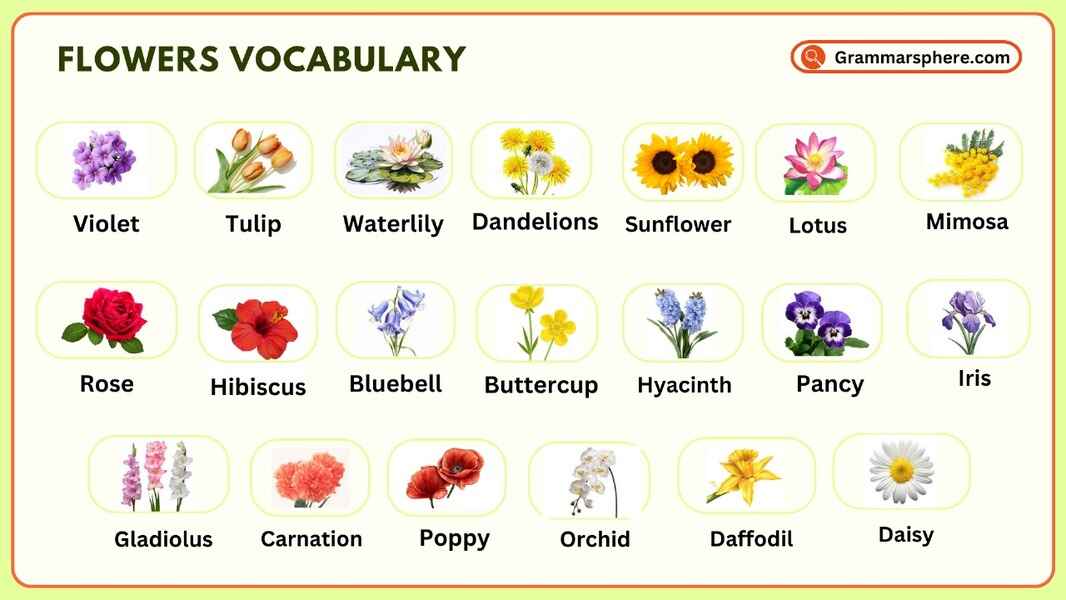
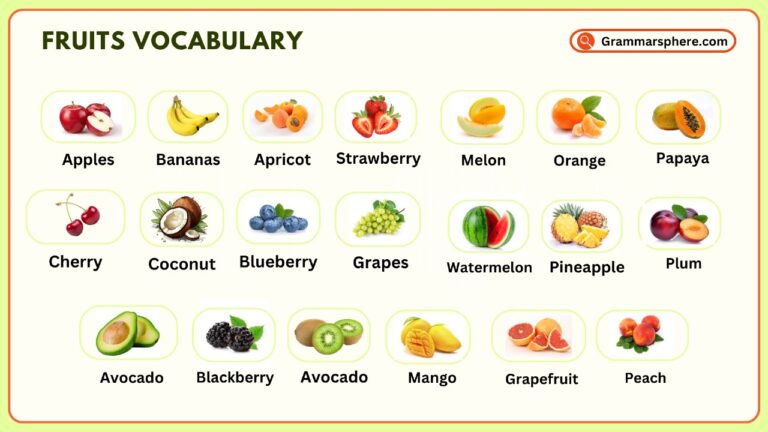
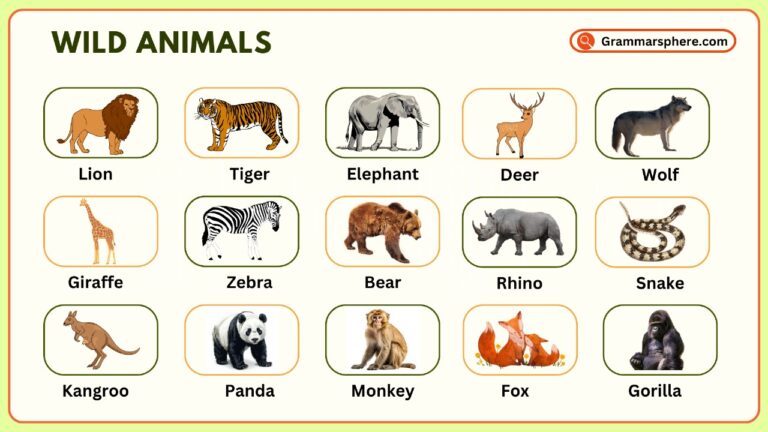
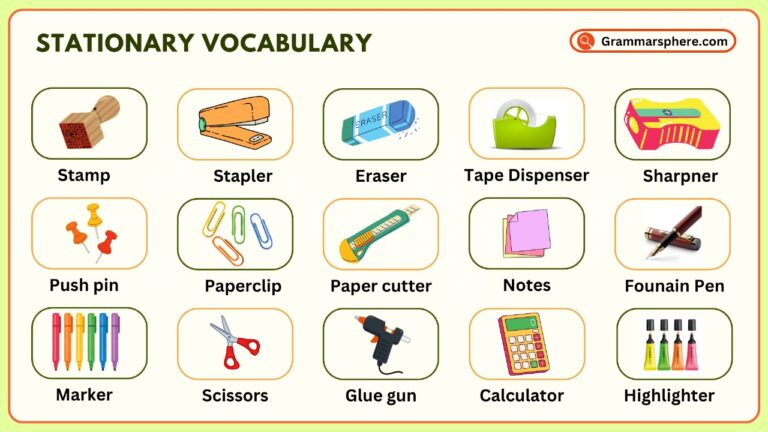
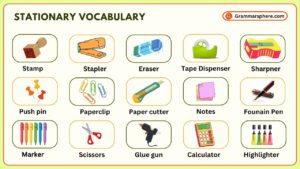
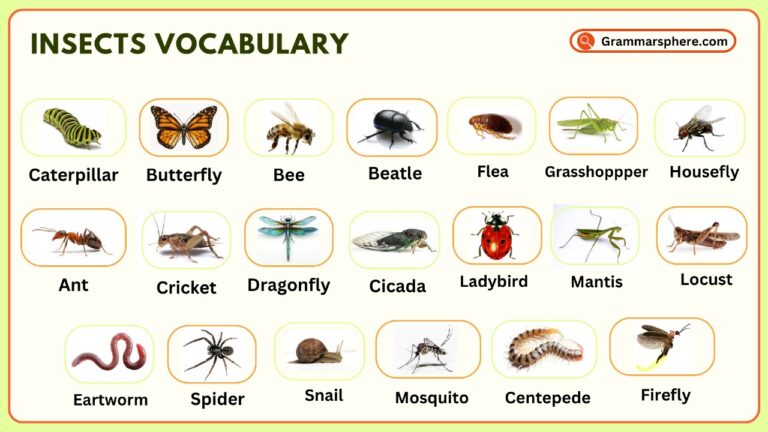
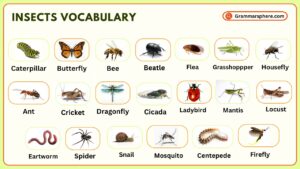
Leave a Comment